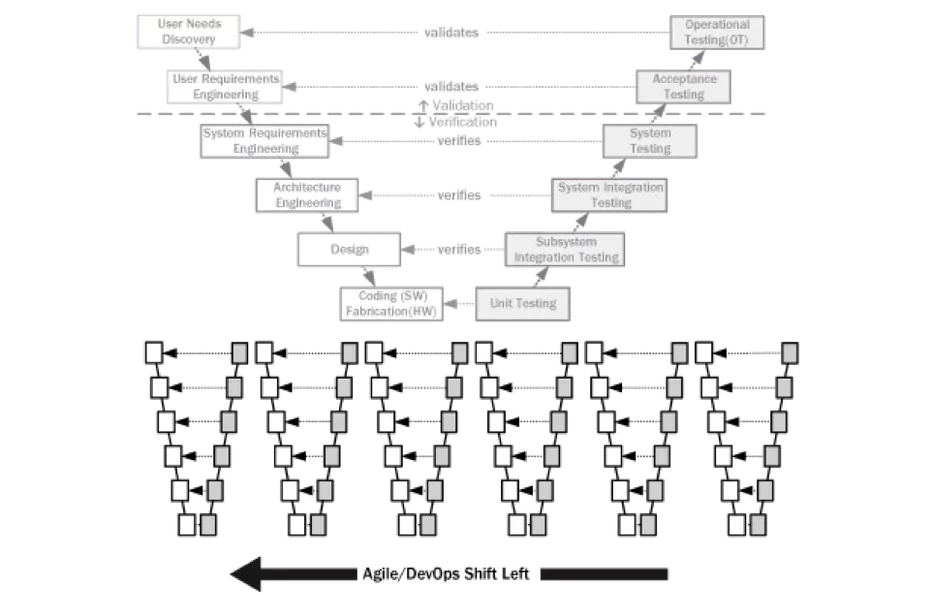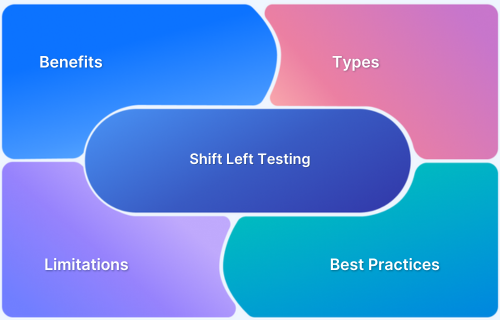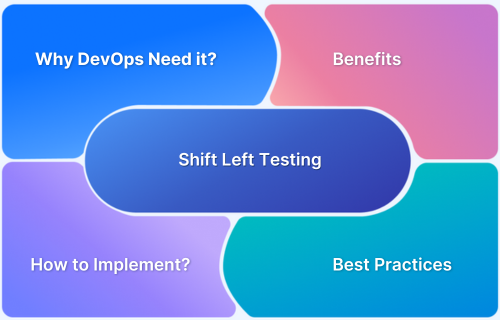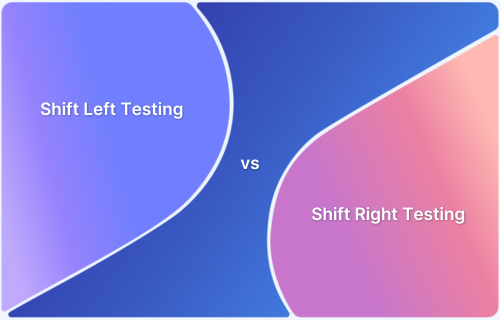DevOps Shift Left Testing: A Detailed Guide
By Sourojit Das, Community Contributor - December 12, 2024
Agile and DevOps teams must adopt new methodologies to avoid falling behind as the need for rapid delivery of high-quality software products continues to grow. Continuous testing and shift-left testing are two innovative approaches to software delivery in the modern day. In this blog post, we will discuss these two concepts, their advantages, and how to implement them in your software development life cycle (SDLC).
- What is Shift Left Testing?
- What is Shift-left Testing in DevOps?
- What is Continuous Testing in DevOps?
- Activities in DevOps Shift Left Testing
- DevOps Shift Left Testing Tools
- How does the Shift-Left Approach Work?
- Why Shift-left Testing Matters in Continuous Testing
- How to Apply Shift-left Testing in Continuous Testing
- Steps to apply Shift-left Testing in Continuous Testing
What is Shift Left Testing?
Shift-Left Testing is the technique of shifting testing, quality assurance, and performance assessment tasks to the “left” of the conventional software development lifecycle. The ultimate objective of shift-left testing is to find and resolve errors early in order to prevent having to redesign the codebase later, hence ensuring on-time product delivery and boosting overall development pace and dependability.
It adheres to the Test Early and Test Often tenet of DevOps and aids in anticipating changes during the development process that may affect product performance or other delivery procedures. Shift-Left should preferably begin before the creation of the codebase and begin verification of APIs, container setups, microservice interactions, etc. from the base technical documentation.
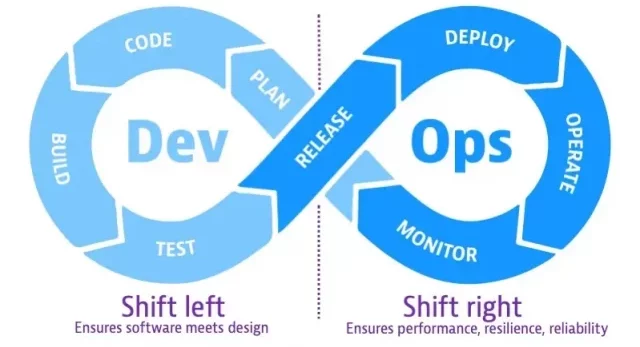
What is Shift-left Testing in DevOps?
DevOps is not only a technology, but also a culture that gives enterprises embracing it extraordinary chances and benefits. As a result, it has been the most sought-after technology over the years, enabling faster and continuous development, deployment, automation, and monitoring. Yet, several elements and concepts contribute to the current state of this technology.
The Shift-Left technique is one of these key DevOps components that enables teams to build and deliver high-quality apps and features swiftly and reliably, without compromising the performance and functionality of the system.
Due to the importance of the Shift-Left methodology to DevOps and its successful operations, it is essential that we comprehend its concepts and the function it plays in DevOps development processes.
The Shift-Left technique, or as it is often known, Shift-Left Testing, was coined by Larry Smith in 2001. It is an essential software testing approach where testing is undertaken early in the development lifecycle. Its primary goal is to test software frequently and early in order to make it better and faster by providing quick, early, and effective debugging.
The Shift-Left methodology has been essential throughout the years because it enables developers to focus on software quality and security early in the SDLC, rather than after errors and problems are discovered. This enables the team to consistently offer high-quality, dependable software and features. Moreover, with the aid of this method, teams can complete daily chores such as:
- Assurance and testing of quality.
- Offering feedback
- Examining changes and advancements.
It also aids the team in adapting to shifting expectations and requirements, controlling rising costs and time-to-market, and successfully addressing unforeseen problems earlier in the development pipeline.
As depicted in Figure below, Agile and DevOps projects utilise a large number of Vs with short durations (also known as sprints) as opposed to a single or limited number of Vs as in the two preceding examples of shift-left testing. These minor Vs would also be updated if one or more early sprints are utilised to outline the fundamental requirements and architecture, or if test-first and test-driven development (TDD) are implemented.
Because the types of testing on the right side of the earliest of these tiny Vs are to the left of the types of testing on the right side of the larger V(s) they replace, a shift to the left happens. Agile testing is often limited to developmental testing and does not cover operational testing, which occurs after a system is put into service and is depicted in the figure. Currently, the transition to Agile/DevOps shift-left testing is prevalent and ongoing.
What is Continuous Testing in DevOps?
Continuous testing entails testing frequently and frequently throughout the development lifecycle. Using continuous testing in your organisation’s testing strategy reduces time-to-market while maintaining (or perhaps improving) the quality your consumers demand.
In addition, continuous testing enables developers to receive regular feedback in order to address errors before deployment into production. Imagine being able to raise your output quality even more quickly through automated testing at each stage. Automation is not required for continuous testing, but it speeds up the process and is therefore strongly encouraged.
Read More: What is Continuous Testing in DevOps
Activities in DevOps Shift Left Testing
Typical actions conducted by a team employing a shift-left strategy include:
- Testers help developers implement unit testing.
- Planning, developing, and automating integration tests are included.
- Plan, develop, and utilize virtualized services at each level and component.
- Collect, rank, and process feedback.
- Assess the quality as the project evolves.
DevOps Shift Left Testing Tools
In DevOps, “Shift Left Testing” emphasizes addressing issues early in the development lifecycle. By integrating testing and security from the beginning, development teams can identify potential problems sooner, enhance code quality, and speed up delivery.
- SAST (Static Application Security Testing): SAST scans source code, bytecode, or binaries for vulnerabilities without running the application. This proactive approach identifies coding errors, security risks, and bugs early in the development process.
- DAST (Dynamic Application Security Testing): DAST evaluates running applications to uncover security vulnerabilities like SQL injections, cross-site scripting, and other threats in real-time. It focuses on identifying flaws while the application is actively running.
- IAST (Interactive Application Security Testing): IAST combines features of both SAST and DAST, working within the application during runtime. It monitors and analyzes the app’s behavior, providing real-time feedback on security weaknesses and vulnerabilities.
- RASP (Runtime Application Self-Protection): RASP secures applications during runtime by continuously monitoring app behavior and preventing attacks without needing external intervention. It helps to protect applications from exploitation in real-time.
- Containers: Containers encapsulate applications and their dependencies, ensuring consistent execution across varied environments by isolating the application from the underlying infrastructure. Security tools for containers scan container images for vulnerabilities and enforce security policies, securing the containerized infrastructure.
- Cloud Security Posture Management (CSPM): CSPM tools monitor cloud environments for misconfigurations, ensuring they follow security and compliance guidelines. These tools detect risks and help remediate them, preventing sensitive data exposure or compliance violations.
- Firewall Tools: Firewalls inspect and manage inbound and outbound network traffic, enforcing security policies through predefined rules to protect the network from unauthorized access and potential threats.tor and control incoming and outgoing network traffic based on predefined security rules.
- Dependency Scanning: These tools analyze the external libraries, frameworks, and dependencies integrated into the application code to identify known vulnerabilities, ensuring that third-party software doesn’t introduce security risks.
- Secrets Detection: Secrets detection tools search for sensitive information like API keys or passwords accidentally committed in source code. They help prevent security breaches by alerting teams to potential exposures before they can occur.
- Unit Testing Tools: Unit testing tools automate the validation of individual components or functions within an application. Tools like JUnit, NUnit, and pytest are widely used to verify that each component works as expected.
- Code Review Tools: These tools assist in reviewing code quality by identifying potential issues, bad coding practices, and maintainability concerns. BrowserStack Code Quality tool provide detailed analyzes on code structure and adherence to best practices, ensuring higher-quality code.
- CI Tools (Continuous Integration): CI tools automatically build and test code changes in shared repositories to detect integration issues early. Popular CI tools like Jenkins, GitLab CI, CircleCI, and Travis CI streamline the development process and ensure smoother deployments.
- Test Automation Tools: These tools automate UI testing across multiple browsers and devices, ensuring cross-platform compatibility. Tools like BrowserStack Automate allow for real-time testing, accelerating the validation process.
- Test Management Tools: Test management platforms help plan, organize, and track testing efforts for web and mobile applications. Tools like BrowserStack Test Management integrate with CI/CD pipelines, allowing teams to track defects and ensure thorough execution through a centralized interface.
- Mocking and Test Data Generation Tools: These tools generate mock data or simulate external services to create controlled environments for testing software components that rely on APIs or databases. This ensures robust testing without needing access to live systems.
By utilizing the correct Shift Left Testing tools, development teams can mitigate risks, enhance software quality, and streamline the process, ultimately delivering secure, reliable, and high-quality software at a faster pace.
How does the Shift-Left Approach Work?
There are two implementation strategies for the shift-left methodology in DevOps:
Moving operation to the left by building deployment and testing processes in tandem with the development team. This will enable the development and operations teams to assume responsibility for establishing standard deployment methods and validating them in a test environment prior to deployment to the production environment.
Lowering the failure rate by simulating the production environment in all pipeline scenarios using Cloud pattern capabilities. This assists in eliminating failures caused by setup inconsistencies. The development and operations teams collaborate once more to construct the provisioning procedure.
Why Shift-left Testing Matters in Continuous Testing

QA teams should care about shift-left testing because it stresses the test early principle. Companies are increasingly realising that style is not favourable to rapid releases. Time is, after all, money. By shifting testing techniques to the left and including testing as early as feasible, software companies can beat their competitors to the market.
Although shift-left testing may appear to be the ideal way to aid in the testing process prior to the release of new products, the technique alone is insufficient.
The ultimate goal is to automate and test as many components of the product as feasible while minimising the testing phase’s time commitment. Thus, shift-left testing should be implemented.
Shift-left testing should be implemented into continuous testing so that testers can build more frequent, comprehensive, and realistic tests with the use of actual functional data. The combination of “shift-left continuous testing” and “continuous testing” increases the automation of your application testing and guarantees that it is deployed as frequently, as early, and as continuously as feasible throughout the product development pipeline.
In other words, by merging shift-left testing and continuous testing, early defect discovery may be performed more efficiently, resulting in higher quality feedback and faster problem resolution with less work.
How to Apply Shift-left Testing in Continuous Testing
Continuous testing includes shift-left testing, which applies the same testing procedure at every stage and as frequently as possible. Continuous testing encompasses the entire DevOps pipeline (i.e., from planning to deploying), shift-left takes a portion of each cycle and establishes testing strategies for each task in the cycle. Continuous testing is strengthened by shift-left testing, making it more effective against bugs.
Furthermore, shift-left testing can be implemented using behavior-driven development (BDD). BDD is a flexible Agile approach to software development that improves collaboration between developers and non-technical team members such as managers.
Pro Tip : Starting with developer testing, all tests must be executed under real user conditions on actual devices. Effective software testing can only be conducted under actual user situations. Emulators and simulators cannot deliver 100 percent correct results; consequently, developers cannot evaluate the quality of their code adequately. Any results obtained from testing on emulators or simulators would be only partially accurate, and as a result, software development activities based on these results would not result in the production of high-quality software.
Whether performing manual testing or automated Selenium testing, genuine devices are indispensable. Use cloud-based testing infrastructure in lieu of an in-house device lab (which is regularly updated with new devices and maintained at the highest levels of functioning). BrowserStack provides access to over 3500 real browsers and devices for testing from anywhere in the globe, at any time.
Steps to apply Shift-left Testing in Continuous Testing
1. Invite developers to participate in testing
When developers test their code before merging it with the main branch, the merged code is more error-free and tidier. Separate code units that are smaller and more accessible are simpler to test.
2. Educate testers in coding
Agile in its optimal form and most implementations of DevOps necessitates that developers test and testers code. Neither is expected to be an authority in a field that is not their primary focus. However, developers should be able to execute intermediate-level tests, and QAs should be able to perform rapid fixes whenever possible.
Basic coding abilities enable testers to be effective at code reviews and useful sprint team members. Testers must be capable of reading and modifying simple code, such as an automated test or reworking essential routines.
Must Read : Why does DevOps recommend Shift Left Principles
3. Introduce testers early
Shift Left Test in Agile is most effective when QAs are brought in during the initial brainstorming session. QAs must be present when developers discuss how to construct a website or application. This enables them to better create tests for the Continuous Testing phase because they have a better grasp of the underlying principles. Having QAs there can also provide developers with a clear picture of what bugs are likely to appear and how to avoid them.
The success of DevOps depends on automation. To design meaningful test cases, QAs must understand how the code is being shaped and what is expected of the end product. They cannot be expected to crawl through each line of code in search of every misplaced semicolon. In addition, when developers test their code, they may need guidance from QAs regarding what to look for.
4. Consider testability while coding.
Collaboration, like everything else in Agile processes and DevOps, is the key to success. Shift Left Testing success also demands teamwork. It cannot be something done solely by specific individuals at the end of a sprint (designated testers). Developers should question themselves while writing code, “How can I make it more testable?”
This could involve exposing a hook or assigning a unique ID to an element. In addition, this mode of thinking alerts developers to concerns that may compromise functionality or cause operational problems. When software is designed with testing in mind, Shift Left Testing becomes significantly simpler.
Benefits of Shift Left Testing in DevOps
The benefits of Shift Left Testing in DevOps lie in its ability to integrate testing early in the development process, leading to faster, more reliable, and higher-quality software delivery.
Here are some of the key benefits of DevOps Shift Left Testing listed below:
- Early Detection of Defects: Shift Left Testing allows for earlier identification of issues in the development lifecycle, which reduces the cost and time needed for bug fixes. This proactive approach helps identify and resolve defects before they can impact production.
- Faster Time to Market: By integrating testing early and often, teams can detect and resolve issues quickly, leading to faster development cycles and shorter release times.
- Improved Code Quality: Continuous testing and feedback help developers maintain high-quality code throughout the process, preventing the accumulation of technical debt and ensuring better software performance.
- Reduced Costs: Catching defects early in the development phase is more cost-effective than fixing issues later in the process, especially during production. Early testing reduces the likelihood of expensive post-release bug fixes.
- Enhanced Collaboration: With testing integrated into every stage of development, teams (including developers, testers, and operations) collaborate more effectively. This ensures that everyone is aligned on quality and performance goals from the start.
- Continuous Integration and Continuous Delivery (CI/CD) Enablement: Shift Left Testing facilitates the seamless integration of automated testing within CI/CD pipelines, supporting faster and more reliable deployments.
- Better Risk Management: By catching security vulnerabilities, performance issues, and functional bugs early, Shift Left Testing helps mitigate the risks associated with application failures and security breaches.
- Improved User Experience: Early testing of features and functionality leads to better-quality applications, resulting in a smoother, more reliable user experience.
- Faster Feedback Loops: Frequent testing allows teams to receive feedback quickly, making it easier to adapt and iterate on features, improving the overall software development lifecycle.
- Higher Confidence in Releases: Continuous testing throughout development increases confidence in the quality of the software being delivered, reducing the likelihood of defects in production.
Challenges of DevOps Shift Left Testing
Here are some of the core challenges faced in DevOps Shift Left Testing:
- Planning: Shift-left testing can be challenging to implement without an appropriate plan in place prior to implementation.
- Project Management Challenges: Prepare and teach your project managers appropriately to include shift-left testing in their processes.
- Quality assurance risks: Keeping high quality standards during the training and transition phase
- Challenges with Developers: Developers can be resistant to testing and must be prepared to acquire testability abilities.
- Teams working Silos: Minimise the number of silos in your organisation in order to provide rapid feedback and solve problems more quickly and efficiently.
- Frequency of Audits: If your firm does not conduct frequent code audits, be careful to implement them to check that the new testing approach is functioning as intended.
Solution:
BrowserStack Test Management Tool helps overcome the above mentioned challenges with its seamless and centralized test management system which makes project management and test case prioritization easier.
Test Management Tool integrates well with different CI/CD tools hence promotes DevOps Shift Left Testing at its core.
Best Practices for Shift Left Testing in DevOps
Here are some of the best practices to follow for Shift Left Testing in DevOps:
1. Plan ahead
Develop in a manner that is conducive to Shift Left Testing. Once requirements have been identified, developers and testers should rapidly and gradually brainstorm how to design coding and testing. Depending on product requirements and team constraints, specific techniques may need to be developed to fit the Shift Left methodology. In Shift Left Testing, planning and creating test strategies early on are encouraged.
Must Read : DevOps Testing Strategy
2. Use Code Static Analysis
Analysis of code without execution is known as static code analysis. It examines the fundamental code structure and verifies that the code adheres to a variety of standards and guidelines. In general, static analysis searches for the following issues:
3. Programming errors
- Infractions to generally accepted coding standards
- Syntax abnormalities
- Security concerns
In the absence of automation, static code analysis is impossibly laborious. Before moving to QA, the software should scan every untested code in a project. A static code analyzer compares the code to a set of established standards and criteria to determine compliance.
If the analyzer identifies any problems, a human developer or tester must ensure that they are not false positives. Then, developers can repair obvious errors and send the code to testers.
4. Continuously provide feedback
Developers and testers should receive as much feedback as possible throughout the program lifecycle. This enables holes to be corrected instantly and provides everyone with a better understanding of any important trends that emerge throughout testing. It can also be useful for future initiatives, particularly those that are similar to the current one.
5. Specific Quality Norms
Keep in mind that developers are typically not educated in testing from scratch. Hence, it is unreasonable to expect them to intuitively comprehend the nuances of testing. QAs and QA managers should explain the desired level of quality, performance, and operational success of the code so that developers conducting tests know what defects to search for. They must have a clear understanding of what is non-negotiable and what issues can be sent to quality assurance (preferably with a few lines of context). Clarity on software quality standards also enables tests to use the appropriate level of rigour to uncover problems in their own code.
Must Read: How to set goals for Software Quality
Why use BrowserStack Automate for Test Automation in Shift Left DevOps?
BrowserStack Automate offers Continuous Testing supporting Shift Left in DevOps. Some of the major advantages of using BrowserStack Automate with CI tools for test automation include:
- Seamless Integrations: Compatible with popular CI tools like Jenkins, GitLab CI/CD, and Azure DevOps, BrowserStack makes it easy to include real-device testing in CI/CD workflows.
- Real User Environment: Run tests on actual browsers and devices, which improves accuracy over emulators and helps catch environment-specific bugs.
- Parallel Testing: Run multiple tests at once, reducing testing time and accelerating releases.
- Self-Healing Tests: AI-powered self-healing minimizes test flakiness by adapting to minor UI changes, which boosts reliability.
- Scalability: BrowserStack’s cloud-based infrastructure allows teams to scale up or down as needed, providing flexibility and reducing the infrastructure burden on development teams.
These benefits make BrowserStack a valuable addition for teams looking to optimize test automation and enable Shift Left Testing in DevOps, delivering high-quality software faster. For more on these integrations, visit BrowserStack’s Automate Integrations.
 Conclusion
Conclusion
Shift Left testing in DevOps results in an error-free development process and prevents issues from exploding just before production. It decreases the time and effort required to fix faults and increases confidence in the development process as a whole. Shift Left ensures that quality is maintained and product release velocity is not hindered despite the fact that software teams are attempting to gain a competitive advantage by shipping code more quickly and frequently.
By executing tests on a cloud of real devices, Shift Left Testing may be undertaken with the guarantee that results are always accurate. Thorough and error-free testing, beginning at the level of development, avoids issues from appearing (often magnified) at later stages, hence reducing the time and effort required to address them. Before submitting code, it is nearly always simpler to repair errors that developers identify. It also expedites the software’s release to the market and decreases the risk of income and credibility loss owing to fully avoidable defects.
